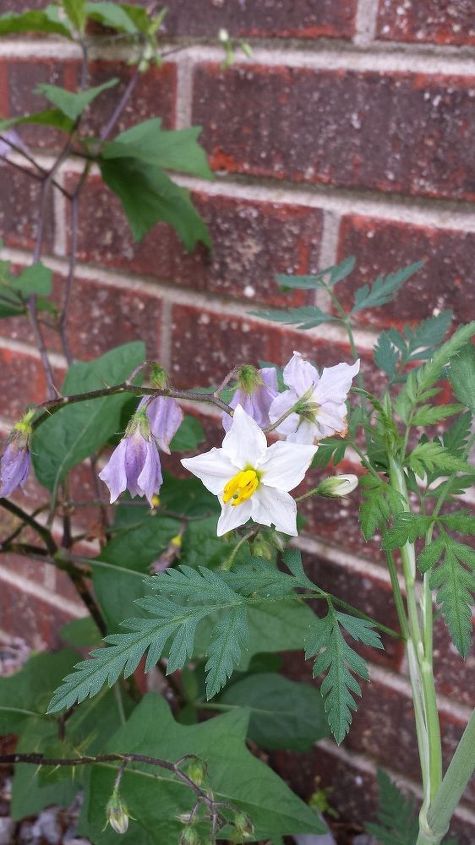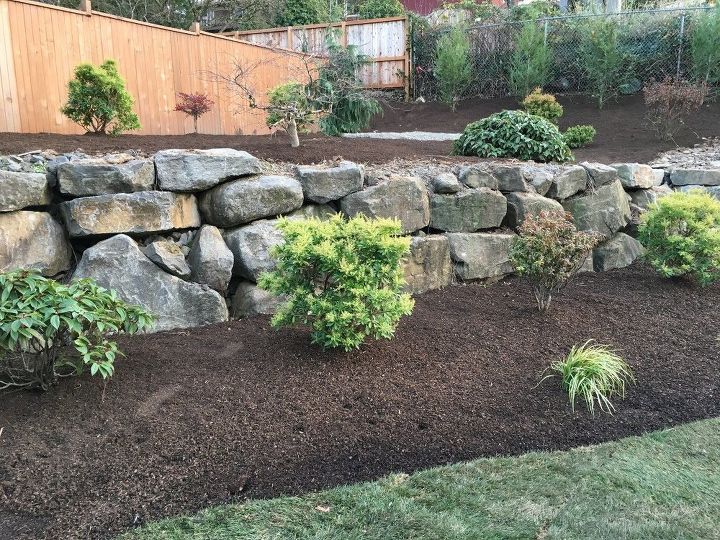What plant is this?
-
Belladonna. Also known as Deadly Nightshade. Poisonous.
 Dianne Snow
on May 29, 2016
Helpful Reply
Dianne Snow
on May 29, 2016
Helpful Reply -
-
Solanum dulcamara - For information : https://en.wikipedia.org/wiki/Solanum_dulcamara
 Claudette
on May 29, 2016
Helpful Reply
Claudette
on May 29, 2016
Helpful Reply -
-
This is horsenettle, or Solanum carolinensis
 Ann Riffe
on May 29, 2016
Helpful Reply
Ann Riffe
on May 29, 2016
Helpful Reply -
-
Horsenettle is an erect perennial weed. The leaves of horsenettle alternate on stems that contain spines. Horsenettle leaves range up to seven inches in length and 1- to 2-inches wide with wavy to coarsely lobed edges. The veins of the leaves as well as the petioles contain spines. Horsenettle spreads by rhizomes and seeds. The flowers of horsenettle are purple to white in color and occur in clusters on spiny flower-stalks. The anthers of the flower are yellow. Flowers occur during the summer. The fruit is smooth globe shaped; the size of a marble. Fruits are light green in color with green coloring, but turn yellow at maturity. Horsenettle is found in pastures, orchards and landscape beds. Horsenettle will grow in a variety of soil types, but does best in sand soils. Horsenettle is found in the eastern United States, west to Kansas and Texas. Distribution Germination Dates 3: May-June 4: May 5: May 7: April 8: March 9: March Cultural Practices Horsenettle is an upright perennial which cannot compete in regularly mowed areas. Horsenettle can become established along fence rows or other turf areas not regularly mowed. Horsenettle can also complete in ornamental plantings. Caution of thorns should be taken when mechanically removing from landscape bed. All parts of the plant contain alkaloids and should not be eaten. Herbicide Use Make your post-emergence herbicide application to horsenettle that is young and actively growing. Gordon's Control Recommendations: Pre-Emergent Non-Selective GlyphoMate® 41 Weed & Grass Killer Plus Aquatic Herbicide Pronto® Vegetation Killer Post-Emergent PowerZone® Broadleaf Herbicide SpeedZone® Broadleaf Herbicide for Turf Trimec® 1000 Low Odor Broadleaf Herbicide Trimec® 992 Broadleaf Herbicide Trimec® Classic Broadleaf Herbicide Trimec® Southern Broadleaf Herbicide for Sensitive Southern Grasses Specialty Products Other Choices Look Alikes
 Ann Riffe
on May 29, 2016
Helpful Reply
Ann Riffe
on May 29, 2016
Helpful Reply -
-
I didn't know what it was, but for a weed, it is very pretty.
 Karen Wilson
on May 29, 2016
Helpful Reply
Karen Wilson
on May 29, 2016
Helpful Reply -
-
A lot of weeds are so pretty and make pretty in vases.....beauty is in the eye of the beholder.
Barb on May 29, 2016
Helpful Reply -
-
I would have thought it was a Clematis Vine, but it seems like it's a weed! A pretty weed, though!
 Linda St. Laurent
on May 30, 2016
Helpful Reply
Linda St. Laurent
on May 30, 2016
Helpful Reply -
-
Does it get berries? Google images for Deadly Nightshade. I think it is a very poisonous plant, both the leaves and berries. You wouldn't want it around if you have children who might try the berries!
 Trudy
on May 30, 2016
Helpful Reply
Trudy
on May 30, 2016
Helpful Reply -
-
Definitely nightshade. Very toxic
 Lori
on May 30, 2016
Helpful Reply
Lori
on May 30, 2016
Helpful Reply -
-
Yes it does get berries.
 Linda
on May 30, 2016
Helpful Reply
Linda
on May 30, 2016
Helpful Reply -
-
When I want to identify plants I email them to our County Extension office. They are so helpful and have access to tons of information. That's a beautiful little flower
 Cor5162059
on May 30, 2016
Helpful Reply
Cor5162059
on May 30, 2016
Helpful Reply -
-
There's actually two plants in the photo. One is definitely a nightshade (toxic), the other looks like a queen anne's lace or some variation of.
 Txt4258973
on May 30, 2016
Helpful Reply
Txt4258973
on May 30, 2016
Helpful Reply -
-
It is not DEADLY NIGHTSHADE. It is horsenettle. It is in the nightshade family as are tomatoes, peppers, eggplant to name a few. Deadly nightshade has no thorns and purple-black berries about the size of a pearl. Horsenettle will have a berry about the size of a small grape tomato. It will be green and turn yellowish as it ripens. Many of the plants in the nightshade family are poisonous, (including tomatoes if you eat the leaves) so it is best to get rid of it if you have small children playing in the area.
 Ann Riffe
on Jun 01, 2016
Helpful Reply
Ann Riffe
on Jun 01, 2016
Helpful Reply- See 1 previous
-
-
If you look at the flowers and get a picture of an eggplant flower, they are similar
 Ann Riffe
on Jun 01, 2016
Helpful Reply
Ann Riffe
on Jun 01, 2016
Helpful Reply -
-
Go to weedalert.com and look up horsenettle. It has pictures of the weed and of the flowers.
 Ann Riffe
on Jun 01, 2016
Helpful Reply
Ann Riffe
on Jun 01, 2016
Helpful Reply -
Related Discussions
GNATS - How to get rid of them?
Somehow my house and garden got tiny gnats that killed my fuchsia plant and fly everywhere. I have tried ALL the Web recommendations - soap and oil dishes, sand in th... See more
Marigolds growing! Should I pinch the buds?
My marigold plants are growing. I heard that pinching the buds until Autumn will allow them to grow without killing the plant. Is this true?
Growing garlic
Growing our first garlic, should we wait until the leaves are drying out before we pick it? Husband picked first one today along with our first potatoes.
How to keep mice out of your garden?
Hi everyone, I have mice in my garden destroying my vegetables and I have also noticed them in the barn and shed. Please can someone tell me how to prevent them from ... See more
What's the best flower/plant to grow in Texas?
I know that opinions vary, but what's your opinion?!I have great luck w Rosemary plants. Green all year long.
What type of plants can be used to plant in boulder wall crevices?
I forgot what I planted!
Can anyone identify these young veggie plants please? I get my seeds from food we buy from the shops, germinate them in tissue, and plant in our gardens. I have plant... See more




